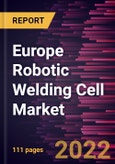The robotic welding cell market in Europe is expected to grow from US$ 185.81 million in 2022 to US$ 268.75 million by 2028. It is estimated to grow at a CAGR of 6.3% from 2022 to 2028.
Industry 4.0 fully automates production processes with minimal to negligible human intervention. It works on the industrial internet of things (IIoT), cyber-physical systems, cloud robotics, cloud computing, and big data. As a result, welding robot manufacturers are moving to produce networked and intelligent robots compatible with Industry 4.0. Many end-use industries, such as automotive and transportation, metals and machinery, electrical and electronics, and aerospace and defense, have begun to implement Industry 4.0 concepts in their manufacturing processes to harness the advantages associated with it, including increased productivity, flexibility, and safety, better quality, decreased need for consumables, and reduced production costs. Smart factories are a key feature of Industry 4.0. A smart factory adopts a so-called calm system. A calm system can manage both the physical world and the virtual. Such systems are called background systems and work somewhat behind the scenes. A calm system is aware of its surrounding environment and the objects around it. It can also be provided with soft information related to generated objects, such as drawings and models. Smart Factory containing hundreds or even thousands of smart devices capable of self-optimizing production will result in virtually zero downtime in production. This is leading to significant growth of the robotic welding cell market.
Industry 4.0 fully automates production processes with minimal to negligible human intervention. It works on the industrial internet of things (IIoT), cyber-physical systems, cloud robotics, cloud computing, and big data. As a result, welding robot manufacturers are moving to produce networked and intelligent robots compatible with Industry 4.0. Many end-use industries, such as automotive and transportation, metals and machinery, electrical and electronics, and aerospace and defense, have begun to implement Industry 4.0 concepts in their manufacturing processes to harness the advantages associated with it, including increased productivity, flexibility, and safety, better quality, decreased need for consumables, and reduced production costs. Smart factories are a key feature of Industry 4.0. A smart factory adopts a so-called calm system. A calm system can manage both the physical world and the virtual. Such systems are called background systems and work somewhat behind the scenes. A calm system is aware of its surrounding environment and the objects around it. It can also be provided with soft information related to generated objects, such as drawings and models. Smart Factory containing hundreds or even thousands of smart devices capable of self-optimizing production will result in virtually zero downtime in production. This is leading to significant growth of the robotic welding cell market.
Market Overview
The Europe robotic welding cell market is segmented into Germany, France, Russia, the UK, Italy, and the rest of Europe. Europe is known for its large-scale industrialization and urbanization. Europe started from a strong position in robotics, holding 32% of the global market. Industrial robotics accounts for about one-third of the global market, while in the smaller professional robotic welding cell market, European manufacturers produce 63% of the non-military robots. Europe is a leader in the robotic welding cell market for field robotics, logistics, and construction. The use of robotics in this market is varied and used in professional cleaning. The military application of robotics is high in the professional use of service robotics. In defense, both manned and unmanned types of robots are used. In unmanned use, drones are very common. The use of drones increased in the battlegrounds over a few years. They are being used for intelligence, surveillance, and reconnaissance missions and help the soldiers on the battlefield and sitting far away to plan their next course of action.Europe Robotic welding Cell Market Segmentation
The Europe robotic welding cell market is segmented into offering, cell type, end user, and country.- Based on offering, the market is segmented into solution and services. The solution segment registered the largest market share in 2022.
- Based on cell type, the market is categorized into pre-engineered cells and custom cells. The pre-engineering segment held the largest market share in 2022.
- Based on end user, the Europe robotic welding cell market is segmented into automotive, manufacturing, and aerospace and defense. The manufacturing segment held the largest market share in 2022.
- Based on country, the market is segmented into Germany, France, Italy, the UK, Russia, and Rest of Europe. Rest of Europe dominated the market share in 2022. ABB Ltd; The Lincoln Electric Company; Kuka AG; Kawasaki Heavy Industries, Ltd.; Zeman Bauelemente Produktionsgesellschaft mbH; Carl Cloos Schweisstechnik GmbH and WEC Group Ltd are the leading companies operating in the robotic welding cell market in the region.
Table of Contents
1. Introduction
3. Research Methodology
4. Europe Robotic Welding Cell Market Landscape
5. Europe Robotic Welding Cell Market - Key Industry Dynamics
6. Europe Robotic Welding Cell Market Analysis
7. Europe Robotic Welding Cell Market Analysis - By Offering
8. Europe Robotic Welding Cell Market - by Cell Type
9. Europe Robotic Welding Cell Market - End-User Industry
10. Europe Robotic Welding Cell Market - Country Analysis
11. Industry Landscape
12. Company Profiles
13. Appendix
List of Tables
List of Figures
Companies Mentioned
- Abb Ltd
- The Lincoln Electric Company
- Kuka Ag
- Kawasaki Heavy Industries, Ltd.
- Wec Group Ltd
- Carl Cloos Schweisstechnik Gmbh
- Zeman Bauelemente Produktionsgesellschaft Mbh
Table Information
| Report Attribute | Details |
|---|---|
| No. of Pages | 111 |
| Published | November 2022 |
| Forecast Period | 2022 - 2028 |
| Estimated Market Value ( $ | $ 185.81 Million |
| Forecasted Market Value ( $ | $ 268.75 Million |
| Compound Annual Growth Rate | 6.3% |
| Regions Covered | Europe |
| No. of Companies Mentioned | 7 |








